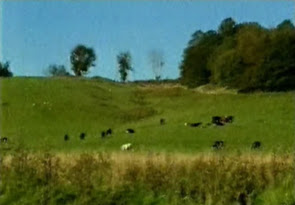All video tape sources suffer from degradation and require electronic adjustment in order to correct playback problems. This ranges from colour problems, noise, horizontal lines, time base errors, drop outs and audio playback problems. Fortunately these days there are many methods to enhance video and audio playback problems.
Video Colour Correction –
Chroma, Luma, Brightness, Contrast, Saturation and Colour Bleeds
 |
| Before Video Colour Correction |
 |
| After Video Colour Correction |
 |
| Before and After Video Colour Correction |
There are two ways to approach this. The first is colour correction on the fly using hardware colour correctors and the second is using software for post processing to enhance videos. For optimal results usually a combination of both is best.
Hardware video colour correctors are extremely useful for adjusting colour casts (unwanted colour tints), boosting saturation and fixing colour bleeds. They operate on the fly and can be adjusted as and when they are required. Hardware colour correctors allow independent red, green and blue adjustments which is useful for giving lovely rich warm wedding video colours or enhancing colour saturations made by the original camcorder. They also have the ability to correct colour bleeds which correctly aligns the colour (chroma) over the image (luma) and gives a far better video transfer. Brightness and contrast are also easily adjustable which especially helps capture the maximum detail in dark footage.
Software video colour correctors are excellent for adjusting colour precisely and enormously improve playback. They are particularly good at removing colour casts and offer far finer adjustments to colour than their hardware equivalents. The downside to software colour adjustment is the length of time for post production to process all the information. Depending on the level of complexity, the correction of a one hour video can take several hours to do! The end results are definitely worth waiting for as videos often come back to life with more saturated punchy colours, “black” blacks and “white” whites. Colour adjustment, brightness / contrast and colour saturation are all very easily corrected. They also have the advantage of fine adjustment in the highlight, midtone and shadow details independently which is extremely useful for correcting chromatic variations over different luminosity.
Colour Noise
There are two types of colour noise – chroma noise and luma noise. Both chroma and luma noise can be removed in a variety of ways. In most cases this can be achieved with video noise reduction filters but in some cases individual frames may have to be replaced.
 |
| Video Noise |
Video noise usually happens at low lighting conditions and always becomes more apparent as the video is lightened and contrast adjusted.
Horizontal Video Line Drop Outs
 |
| Before Horizontal Video Line Removal |
 |
| After Horizontal Video Line Removal |
Perhaps one of the most annoying problems with old video and camcorder tapes is random horizontal lines appearing through your video playback. As it is random it tends to distract more from your viewing pleasure than it would otherwise if it was consistent. Fortunately it is possible to diminish these lines so they are less distracting. There are motion compensated horizontal line filters available which can diminish and in some cases completely remove these lines. The result is a much better playback which is far less distracting to watch.
Analogue video is split up into horizontal lines which are interlaced between odd and even lines making two fields (odd and even lines) that become one frame of video. It was a clever way of halving the bandwidth required for transmission broadcasts without losing quality by reducing the number of lines in the transmission as you are only updating half the frame at any one time.
Video Drop Outs
Video Time Base Correction
 |
| Before Video Time Base Correction |
All decent video to DVD transfer companies should use time base correctors as standard. If they have never heard of time base correction or claim they do not need it then you are not getting the best transfer possible.
 |
| After Video Time Base Correction |
Analogue video is split up into horizontal lines which are interlaced between odd and even lines making two fields (odd and even lines) that become one frame of video. It was a clever way of halving the bandwidth required for transmission broadcasts without losing quality by reducing the number of lines in the transmission as you are only updating half the frame at any one time.
| Zoomed Before Time Base Correction |
Problems occur when storing video copies of these transmissions and also your camcorder recordings. As each alternate line is stored on tape the head alignment can be slightly out of sync with the previous line laid down on tape.
As they are read back, re-assembled into one frame some lines are slightly too far to the left and others are too far to the right. This results in “wobbly” vertical and diagonal lines on the video playback.
| Zoomed After Time Base Correction |
A video time base corrector will examine each horizontal line and assess whether to move the line to the left or to the right in order that vertical and horizontal lines are not skewed or wonky.
Time base correction is only available in high end video transfer equipment and comes with the equivalent price tag! Any decent company transferring videos and camcorder tapes should be using time base correctors as standard.
Video Drop Outs
Video drop outs occur for several reasons but are caused primarily by the videos heads being dirty or a stretched video tape. Firstly make sure that you check the tracking which might just need a simple adjustment. If the recording VCR / camcorder has dirty heads then this will result in a bad recording with the picture momentarily disappearing. If it is the playback VCR / camcorder that has dirty heads then cleaning the heads with some isopropyl alcohol is all that is required to obtain maximum playback quality.
Assuming it is not the VCR player or camcorder that is playing back incorrectly then you will need some post video processing to restore the video. Long length drop outs lasting several seconds long are virtually impossible to remove automatically but can be removed manually. This is very time consuming and expensive as a result. Short length dropouts can be automatically filtered out by freezing the previous last good frame. It can lead to a jumpy video but is far better than losing the picture altogether. Medium length video dropout restoration can be hit or miss. Nice clean drop outs without rolling pictures can usually be blended between the damaged frames to help prevent your eye from being distracted but if there is any picture rolling round then this can be difficult to do automatically and the only option is to manually replace the frames which is very time consuming.
Clipping Video
Sometimes sections of video are just not required and require to be removed. Examples of this are fuzz / rolling picture / broken up picture / black video (lens cap still on) / blue video / accidentally recording the ground and your feet as you forget to turn off the camcorder! It is possible to remove these video clips ensuring that you only receive the video that you want. Simple edits are done as a matter of course but specific clipping of video takes time and requires clients to show the exact clip of the video that is to be removed. This is chargeable on an hourly basis.
Cropping Video
Video tape and camcorder playback often has annoying edge defects or specific colour shifting near the top or bottom of a video but not anywhere else. Often the easiest way to correct this is to crop off the part of the video with the defect. You can mask it by putting black borders on but it is far better to crop into the video and then resize it back up to full frame. This is particularly useful for removing black borders around old analogue video and camcorder transfers. Especially if you are displaying them on web pages where they become very obvious.
Audio Playback Problems
Sometimes audio can be a problem with video playback. Fortunately there is a lot of software out there to help out. The most common problem with audio in video playback is mono output on one channel. This can be the result from old VCR’s or camcorders which do not support stereo recording to dirty audio heads. It is possible to edit the audio so that it is mono on both channels as opposed to just one. Quiet camcorder recordings can be boosted in volume to make them easier to listen to. You can even remove hiss or hum (50Hz / 60 Hz mains). Simple bass or treble boosting can also make a big difference to audio playback resulting in much, much richer sounds.
With audio cassettes sometimes warble can be a problem and although this is difficult to remove completely it can certainly be diminished to the point it no longer becomes irritating to listen to. This is, of course, dependent on the degree of warble!
Like wise clicks, hisses and pops on old vinyl records can be cleaned and restored. The process is never perfect but it certainly makes a huge difference to your old recordings.
Click here for more information on converting video, camcorder and cine film to DVD
Click here for more information on converting video, camcorder and cine film to DVD


